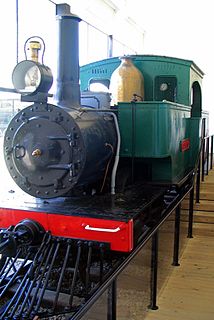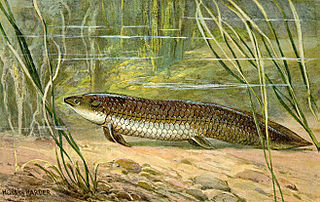
Moa were nine species of now-extinct flightless birds endemic to New Zealand. The two largest species, Dinornis robustus and Dinornis novaezelandiae, reached about 3.6 m (12 ft) in height with neck outstretched, and weighed about 230 kg (510 lb) while the smallest, the bush moa, was around the size of a turkey. Estimates of the Moa population when Polynesians settled New Zealand circa 1300 vary between 58,000 and approximately 2.5 million.

Dacrydium cupressinum, commonly known as rimu, is a large evergreen coniferous tree endemic to the forests of New Zealand. It is a member of the southern conifer group, the podocarps. The former name "red pine" has fallen out of common use.

Naultinus is a genus of geckos that are endemic to New Zealand. On account of their striking colouration, species in the genus Naultinus are commonly known as green geckos. There are nine described species in the genus. Species in the genus share a number of traits that set them apart as quite different from the rest of the world's two thousand odd gecko species, which are generally brown in colour, ovivaparous, short-lived and nocturnal. In contrast, Naultinus are green, ovovivaparous, live up to 30 years or more and are strictly diurnal. New Zealand has a temperate, maritime climate, and in terms of distribution Naultinus is one of the southernmost gecko genera in the world — some species live in habitats in the South Island which receive regular snowfall in winter. Animals in this genus possess several physiological and behavioural adaptations to cope with these periods of low temperatures and adverse weather.

The crimson rosella is a parrot native to eastern and south eastern Australia which has been introduced to New Zealand and Norfolk Island. It is commonly found in, but not restricted to, mountain forests and gardens. The species as it now stands has subsumed two former separate species, the yellow rosella and the Adelaide rosella. Molecular studies show one of the three red-coloured races, P. e. nigrescens, is genetically more distinct.

Coprosma is a genus of flowering plants in the family Rubiaceae. It is found in New Zealand, Hawaiian Islands, Borneo, Java, New Guinea, islands of the Pacific Ocean to Australia and the Juan Fernández Islands.

Rosellas are in a genus that consists of six species and nineteen subspecies. These colourful parrots from Australia are in the genus Platycercus. Platycercus means "broad-tailed" or "flat-tailed", reflecting a feature common to the rosellas and other members of the broad-tailed parrot tribe. Their diet is mainly seeds and fruit.

The South Island piopio also known as the New Zealand thrush, was a passerine bird of the family Oriolidae.

The NZR E class of Double Fairlie steam locomotives were two different types of Fairlie steam locomotives, used on New Zealand's railway network.

Elmisaurus is an extinct genus of dinosaur from the Late Cretaceous. It was a theropod belonging to the Oviraptorosauria. Its fossils have been found in Mongolia. It is known from foot and hand bones.

The Auckland green gecko is a species of gecko found only in the northern half of the North Island of New Zealand, except north of Whangaroa. The Wellington green gecko, formerly considered a subspecies, is found in the southern half of the North Island and the two ranges do not overlap. Its length is up to 145 mm, snout to vent.

Ceratodus was a wide-ranging genus of extinct lungfish. Fossil evidence dates back to the Early Triassic. A wide range of fossil species from different time periods have been found around the world in places such as the United States, Argentina, Greenland, England, Germany, Egypt, Madagascar, China, and Australia. Ceratodus is believed to have become extinct sometime around the beginning of the Eocene Epoch. The closest living relative of Ceratodus is thought to be the Queensland lungfish, Neoceratodus forsteri, which means "new Ceratodus" in Greek.
The smallspine spookfish is a species of fish in the family Rhinochimaeridae with a rather disjunct population. Its natural habitat is open seas.

Scissurella mantelli is a species of minute sea snail, a marine gastropod mollusc in the family Scissurellidae.

Protobothrops elegans is a venomous pitviper species endemic to Japan in the southern Ryukyu Islands. No subspecies are currently recognized. Common names include: elegant pitviper, Sakishima habu (サキシマハブ), and elegant tree viper.

The North Island snipe, also known as the little barrier snipe or tutukiwi, is an extinct species of bird in the sandpiper family, Scolopacidae, that was endemic to New Zealand.

Deinacrida elegans is a species of wētā in family Anostostomatidae. It is endemic to New Zealand.
C. elegans most commonly refers to the model round worm Caenorhabditis elegans. It may also refer to any of the species below. They are listed, first in taxonomic order and, second, alphabetically.
Peripatoides kawekaensis is a species of velvet worm in the Peripatopsidae family. The type locality is in New Zealand's North Island.
Compsopsectra elegans is a species of moth in the family Limacodidae. It is the type species of its genus. The type specimen was from the Philippines islands.

Pounamu or greenstone are terms for several types of hard and durable stone found in southern New Zealand. They are highly valued in New Zealand, and carvings made from pounamu play an important role in Māori culture.














